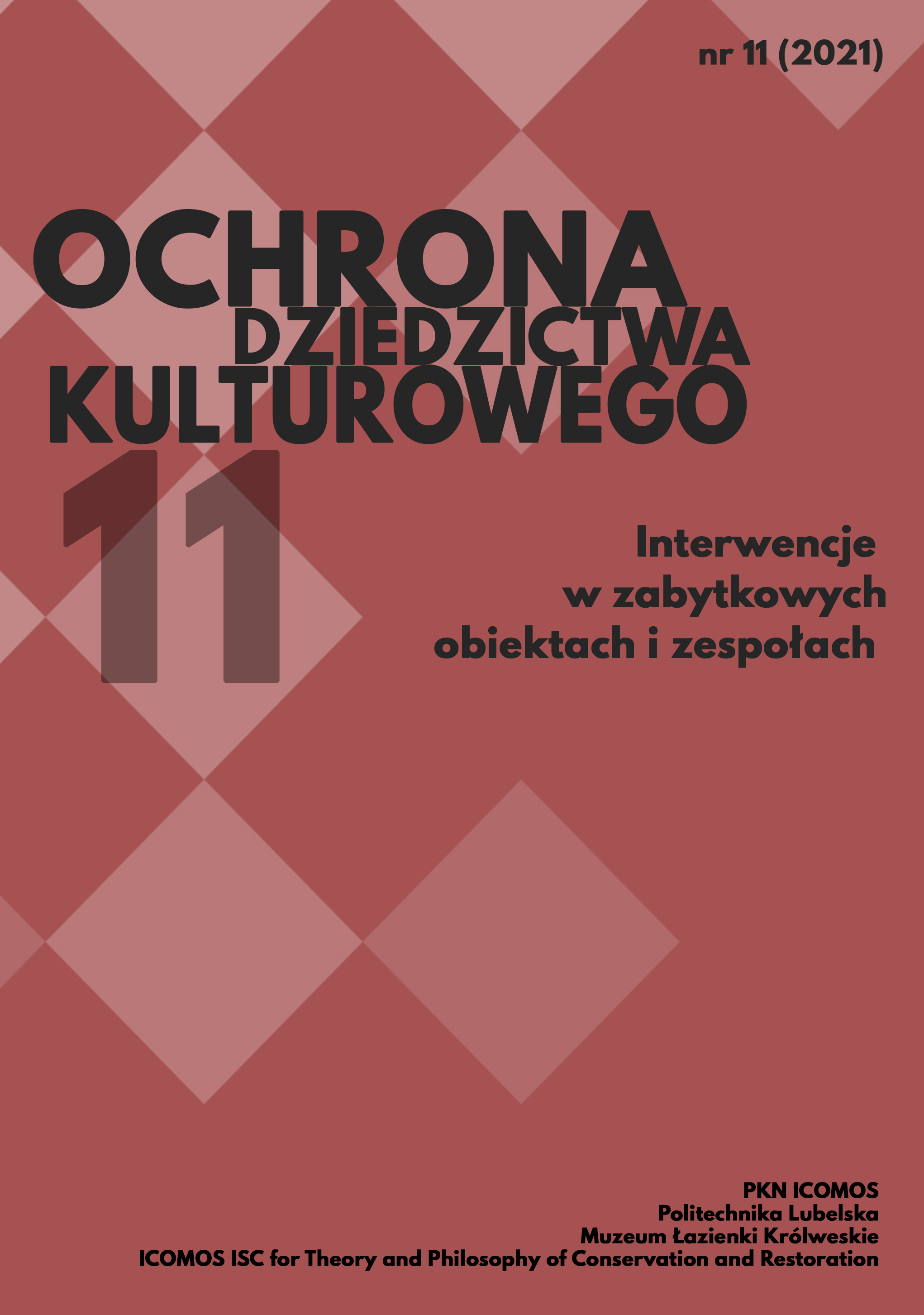Transformation of Historic Buildings – an Attempt at Codification
Article Sidebar
Open full text
Issue No. 11 (2021)
-
Letting Go: the Limits of Intervention
Grzegorz Bukal1-12
-
Transformation of Historic Buildings – an Attempt at Codification
Piotr Molski13-26
-
Problems of Protection of Historical Industrial Buildings on the Example of the Port and Shipyard Complex in Gdynia
Robert Hirsch, Celina Łozowska27-42
-
New Old Town in Elbląg – Multi-faceted Intervention in a Historic Area
Katarzyna Wiśniewska43-64
-
Urban Conservation in International Charters: From the Athens Charter to the Historic Urban Landscape Recommendation
Antonino Frenda, Marco Valle65-74
-
Integrity versus Intervention Boundaries in Modernist Housing Complexes
Case study of the healt/holiday districts in UstrońBłażej Ciarkowski75-86 -
São Luiz do Paraitinga: The Image of São Paulo State in the 18th Century
Rogério Pereira de Campos, Maria Fernanda Rodrigues, Anibal Costa, Humberto Varum87-105
-
Tenement House "Pod Kruki", Market Square 25, Krakow. The Present of History – the Layering of the Future
Marcin Włodarczyk, Małgorzata Mariola Włodarczyk107-126
-
The Latest Strategic Documents Specifying Changes in the Approach to the Modernization of Monuments in Poland
Katarzyna Pałubska, Katarzyna Zalasińska127-142
-
Parks, Gardens and Other Forms of Composed Greenery – Boundary Conditions for Contemporary Interventions
Dorota Sikora143-160
-
Criteria to Be Met by Contemporary Design Works Transforming the Form and Utility Program of Historic Sacred Architecture in the View of Selected Examples from Europe
Konrad Szumiński161-170
-
Analysis of the Component Values of the Historic Urban Complex – the Basis for Conservation Programs and Plans
Boguslaw Szmygin171-179
-
ICOMOS Heritage Impact Assessment – Application to National Conservation Practice
Marcin Górski181-199
Main Article Content
DOI
Authors
Abstract
Civilization development and the related changes in functional, technological, and aesthetic standards are connected with the transformations of the existing buildings, including architectural monuments. Non-conservationist needs and the scale of these transformations influence the reevaluation of the architectural heritage protection paradigm. An important manifestation of this, following the political transformation in Poland after 1989, is the interdependence between effective protection of historic buildings and their utilization. This entails the necessity of modernization and adaptation interventions, i.e. changes of internal divisions and the need to expand the usable area by extending the historic buildings or premises, or construction of new ones in their immediate vicinity. Therefore, the protection of historic monuments requires the integration of activities that preserve the documentary values of the historic fabric with the principles of its adaptation to the current utilitarian needs - as the condition of the monuments' survival. In systematizing the principles of transformation, it is necessary to organize the nomenclature of activities undertaken in relation to historical buildings, which is crucial for the understanding of the principles of protection and dialogue between the participants of conservation and modernization processes. The aim of this paper is: to outline the views on the interference in the monumental structures in the development of Polish conservator's thought as a starting point for the codification of the interference; to diagnose the important conditions which determine the transformation of monuments and the need for dialogue between the participants in the conservation and modernization projects; to try to define the types of transformations with their characteristics, and to formulate conclusions.
Keywords:
References
Gruszecki A., Łysiak W. (1974), Propozycja nowej wersji Karty Weneckiej, Architektura nr 1-2, s. 3-21.
Kurzątkowski M. (1993), Neohistoryzm konserwatorski, Ochrona Zabytków, nr 3, s. 225-226.
Lubocka-Hoffmann M. (2001), W poszukiwaniu tożsamości Balijska. Retro-wersja miasta w oparciu o doświadczenia Elbląga, Tożsamość miasta odbudowanego; autentyzm – integralność – kontynuacja; Gdańsk, s. 66.
Muczkowski J. (1914), Ochrona zabytków, Kraków.
Müller S. (1974), Współczesna forma architektoniczna w ośrodkach zabytkowych w Polsce po 1956 roku, Architektura, nr 1 -2, s. 22–28.
Szmygin B. (2000), Kształtowanie koncepcji zabytku i doktryny konserwatorskiej w Polsce w XX wieku, Lublin, Wydawnictwo Politechniki Lubelskiej, s. 223.
Tajchman J., Arszyński M. (1972), Wybrane zagadnienia słownictwa konserwatorskiego w dziedzinie zabytków architektury – na tle analizy podstawowych pojęć, Kwartalnik Architektury i Urbanistyki, t. XVII, nr 3, s. 236–238.
Tomaszewski A (2012), Konserwacja pomiędzy „estetyką” a autentyzmem w: Święcka E. red. Ku nowej filozofii dziedzictwa, Kraków, Międzynarodowe Centrum Kultury, s. 119-120.
Article Details
Abstract views: 337
License

This work is licensed under a Creative Commons Attribution-ShareAlike 4.0 International License.






